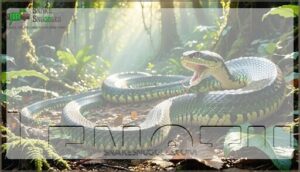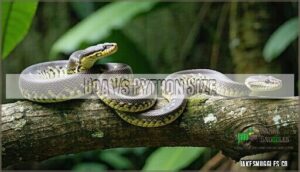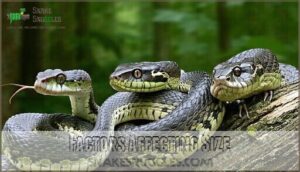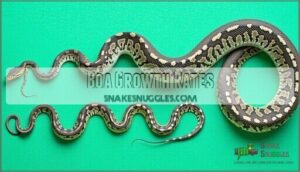This site is supported by our readers. We may earn a commission, at no cost to you, if you purchase through links.
 Imagine a boa constrictor stretched across your living room, spanning from the couch to the opposite wall—that’s about 10 feet of solid muscle. These snakes are some of the largest constrictors you’ll find, but their size differs quite a bit based on genetics, diet, and habitat. While most adults stay between 6 and 10 feet, some can exceed 13 feet if conditions allow. That’s longer than many cars and so heavy it takes two people to lift one safely.
Imagine a boa constrictor stretched across your living room, spanning from the couch to the opposite wall—that’s about 10 feet of solid muscle. These snakes are some of the largest constrictors you’ll find, but their size differs quite a bit based on genetics, diet, and habitat. While most adults stay between 6 and 10 feet, some can exceed 13 feet if conditions allow. That’s longer than many cars and so heavy it takes two people to lift one safely.
Knowing how big boas get is important whether you want one as a pet, study snake biology, or are just interested in these powerful predators. They don’t grow to full size quickly—it’s a slow process affected by everything from their subspecies to their food intake. Males are usually smaller than females, and wild boas rarely get as big as their well-fed counterparts in captivity.
So, let’s explore what shapes the size of these constrictors, from hatchling measurements to record-setting specimens that defy what we think is possible.
Table Of Contents
- Key Takeaways
- How Big is a Boa Constrictor?
- Boa Size Overview
- Largest Boa Records
- Boa Vs Python Size
- Factors Affecting Size
- Boa Growth Rates
- Frequently Asked Questions (FAQs)
- How big do boa constrictors get?
- What is the difference between a male and female boa constrictor?
- Are boa constrictors bigger than pythons?
- Do boa constrictors grow bigger than Imperators?
- How big should a boa constrictor enclosure be?
- Where does a boa constrictor live?
- How big is a full grown boa constrictor?
- What is the largest boa constrictor ever recorded?
- Which is bigger python or boa?
- Is a boa constrictor aggressive?
- Conclusion
Key Takeaways
- Boa constrictors typically reach 6 to 10 feet long, though some can exceed 13 feet, with females growing larger than males due to sexual dimorphism.
- The longest verified boa measured 14.6 feet, while the heaviest reached 60 pounds in the wild (captive boas can approach 100 pounds).
- Growth rates depend heavily on subspecies genetics, habitat quality, and diet—rainforest boas with abundant prey grow larger than those in drier environments.
- Boas are considerably smaller than most python species, with reticulated pythons reaching over 30 feet compared to boas’ maximum of around 13 feet.
How Big is a Boa Constrictor?
When you come face-to-face with a boa constrictor, you’re probably wondering just how big these powerful snakes can get. The answer varies.
While boa constrictors often reach lengths of 6 to 10 feet, some can grow to over 13 feet long. Also, females are usually larger than males—this is known as sexual dimorphism.
A boa’s adult size will depend on its subspecies, diet, and whether it lives in the wild or is kept as a pet.
Boa Size Overview
If you want a clear picture of boa constrictor size, look at length and weight separately. Breaking down these two measurements helps you understand what you’re actually dealing with.
Let’s start by examining how long these snakes get.
Length
Boa constrictors rank among the largest snakes in the world. Most adults stretch between 6 and 10 feet, though exceptional specimens can reach over 13 feet in length.
Here’s what influences their average boa length:
- Females generally get bigger than males, showing obvious sexual dimorphism
- Growth is much faster during the first three years
- Measurement methods must consider the snake’s full extension
- Length differences are strongly tied to genetics and subspecies
Your boa’s greatest length will show its individual growth history and the quality of its care.
Weight
Length is only half the picture—a boa constrictor’s weight shows just how dense and powerful these snakes are.
Mature boas usually weigh 20 to 60 pounds, although females can get over 100 pounds. Your boa’s ideal weight depends on its condition and things that affect its growth—like prey size and how often you feed it.
Feeding too much can lead to obesity, but weight changes between meals are normal and a sign of healthy growth.
Largest Boa Records
Boas usually stay under 10 feet long, but some truly massive individuals have been recorded.
You might be surprised at just how large the biggest ones can get. Let’s explore the largest boas ever documented.
Longest Specimen
The longest boa constrictor with reliable documentation reached 14.6 feet and is preserved at Germany’s Zoologische Staatssammlung München. You may have heard claims about 18.5-foot behemoths, but those turned out to be misidentified anacondas—not actual boas. Verifying records often relies on physical evidence like skins or museum specimens, not just eyewitness testimony.
While boas in captivity sometimes grow to 13 feet with great care, wild boas seldom get longer than 12 feet. These size standards distinguish fact from fiction in boa constrictor size discussions. They’re usually found in tropical Central and South America.
Heaviest Specimen
The heaviest verified boa constrictor weighed 27 kg (60 lb), but some captive boas can get close to 45 kg (100 lb). Wild boas rarely exceed 23 kg because of their environment, but those in captivity often get heavier due to regulated feeding. Sexual dimorphism matters quite a bit—females are usually heavier than males. Reports say the largest boa ever was 18 feet long.
Here’s what affects how big a boa constrictor gets:
- Captive vs wild conditions shape their adult mass through diet control
- Boa mass records are still much smaller than anaconda records
- Weight confirmation distinguishes proven weights from speculation
Keep in mind, these weights are small compared to green anacondas at 97.5 kg.
Boa Vs Python Size
How do boas stack up against pythons? While both are powerful constrictors, boa constrictors are noticeably smaller. Most adult boas reach 6–10 feet and weigh 20–60 pounds, with truly large females reaching around 13 feet and 99 pounds. Pythons, however, vary dramatically by species. Ball pythons stay compact at 3–6 feet and under 5 pounds, but their larger cousins dwarf boas completely. Burmese pythons commonly exceed 16 feet and 200 pounds, while reticulated pythons—the longest snakes on Earth—can surpass 30 feet and 250 pounds.
| Snake Species | Average Adult Length |
|---|---|
| Boa Constrictor | 6–10 feet |
| Burmese Python | 16+ feet |
| Reticulated Python | 20–30+ feet |
Despite their smaller stature, don’t underestimate boa constrictors as capable ambush predators.
Factors Affecting Size
Not all boas grow to the same size, even within the same species. What determines how large your boa constrictor will get? It comes down to a few main factors.
Here are the three main influences on boa size.
Species/Subspecies
The eventual size of your boa constrictor depends on its subspecies; genetics set the stage. South American red-tailed boas (Boa constrictor constrictor) often reach 7–10 feet, while island and dwarf boas from Central America usually stay around 4–6 feet.
Boa constrictor imperator populations vary by region, and ongoing debates about classification actually stem from real genetic differences between these groups.
Your snake’s bloodline matters just as much as the care you provide.
Habitat
A boa’s habitat influences its size; those in rainforests with plenty of resources often grow larger than those in drier environments. Environmental factors such as temperature, humidity, and available prey directly affect how big your boa constrictor can potentially get:
- Rainforest habitats offer lots of prey, which helps them reach their full size
- Savanna adaptations result in smaller adults in drier climates
- Geographic distribution across Central and South America leads to size differences
- Water sources affect metabolism and feeding success
- Conservation impact from habitat loss threatens natural growth patterns
Island populations are usually smaller due to scarce resources.
Diet
The size your boa constrictor attains is a direct result of its diet. In the wild, boas hunt birds, rodents, and even small mammals, feeding when the opportunity arises. Feeding it consistent meals of appropriately sized prey—matching your snake’s mid-body girth—fosters steady growth. In captivity, regular feeding schedules with prey that fulfills all nutritional requirements can allow your boa to reach its full genetic size.
| Feeding Factor | Impact on Boa Constrictor Size |
|---|---|
| Prey size | Larger prey encourages faster growth when appropriately sized |
| Feeding frequency | Regular meals every 7-10 days promote healthy development |
| Nutritional needs | Balanced diet prevents stunted growth and obesity |
| Wild diet | Varied prey provides complete nutrition naturally |
| Captive diet | Controlled feeding lets you manage your boa’s growth rate |
Boa Growth Rates
Boa constrictors grow at wildly different rates. The first few years bring rapid, dramatic growth. After that, they shift into a much slower, steadier progression.
Let’s look at what you can expect from hatchling to full-grown adult.
Newborn Size
A baby boa constrictor is born a miniature predator. Though only about the size of a ruler, it’s fully prepared to hunt from day one. Newborns measure around 12 to 20 inches long and weigh about 2 ounces. These young snakes are immediately independent, with instinctive hunting skills geared toward appropriately sized prey.
They grow quickly, often doubling in size during their first year thanks to frequent meals and regular shedding:
- First shed occurs within days, signaling healthy development
- Early feeding targets small rodents, building strength rapidly
- Growth rates depend on genetics, which affects how large each boa constrictor gets
Boa constrictor growth depends on both diet and environmental conditions from the start.
Adult Size Attainment
Boa constrictors typically reach their full adult size between three and five years of age, though they continue to gain mass well into their teens. Females mature at 6 to 8 feet, while males mature at a smaller size of 5 to 7 feet.
Captive boas with steady feeding routines tend to grow faster than their wild counterparts.
Both genetics and diet create size variations between individual snakes—differences that can shape their adult health and longevity.
Frequently Asked Questions (FAQs)
How big do boa constrictors get?
Boa constrictors usually grow to be 6 to 10 feet long, but some can exceed 13 feet. Females are generally larger than males; this species exhibits sexual dimorphism.
What is the difference between a male and female boa constrictor?
Boa constrictors show sexual dimorphism—females grow considerably larger than males. While females often reach 8 to 10 feet, males typically max out around 6 to 8 feet.
Are boa constrictors bigger than pythons?
Generally, no—pythons tend to grow larger, with some species reaching over 30 feet while boa constrictors usually max out around 10 feet, though python size ranges vary widely by species.
Do boa constrictors grow bigger than Imperators?
Like comparing siblings, "Boa constrictor" and "Imperator" refer to the same species—Boa constrictor imperator is a subspecies of Boa constrictor.
The Boa constrictor constrictor grows to be larger, though genetics and care influence size and growth potential in these subspecies.
How big should a boa constrictor enclosure be?
Your boa constrictor’s enclosure requirements scale with its adult size—plan for minimum dimensions allowing the snake to stretch fully.
Housing requirements for large boas demand enclosures at least as long as the snake’s body length, with adequate vertical space needs for climbing enrichment.
Where does a boa constrictor live?
From Argentina’s grasslands to Mexico’s forests, boa constrictors flourish across diverse ecosystems throughout Central and South America.
These adaptable snakes can be found in tropical rainforests, dry savannas, and even agricultural areas—wherever dense vegetation and water sources facilitate their ambush hunting lifestyle.
You’ll spot them in tropical rainforests, dry savannas, even farmland—basically anywhere with enough cover and water to support their sit-and-wait hunting style.
How big is a full grown boa constrictor?
Boa constrictors typically grow to be 6 to 10 feet long, though females are usually larger than males due to sexual dimorphism.
Some unusually large snakes can exceed 13 feet, but these giants are uncommon in both wild and captive populations.
What is the largest boa constrictor ever recorded?
The longest boa constrictor ever documented measured over 13 feet and weighed about 150 pounds. While older accounts mention even larger snakes, verifying these claims is difficult due to measurement inaccuracies and size exaggerations.
These unusual specimens remind us that superior genetics and favorable conditions can drive boa constrictor size far beyond typical expectations.
Cases like these show what’s possible when a boa gets the genetic jackpot and grows up in ideal conditions—they can blow past normal size limits.
Which is bigger python or boa?
Pythons generally get much bigger than boa constrictors. Reticulated pythons can grow to over 30 feet long, but even the biggest boas rarely get longer than 13 feet.
Both are strong constrictors, but pythons win when it comes to size.
Is a boa constrictor aggressive?
Boa constrictors are generally quite docile and not usually aggressive. If you handle your boa gently and take good care of it, it will likely remain calm and seldom bite.
They only become defensive when they feel threatened or stressed, so interacting with them gently and consistently helps them stay relaxed.
Conclusion
Knowing how large a boa constrictor gets isn’t just about the numbers; it’s about appreciating the imposing nature of these strong snakes. They range from relatively slim six-footers to truly impressive thirteen-footers, and their size is influenced by genetics, diet, and their surroundings.
Understanding a boa constrictor’s size goes beyond measurements—these powerful snakes command attention. You’ll find everything from sleek six-footers to massive thirteen-foot specimens, with their ultimate size shaped by genetics, what they eat, and where they live.
If you’re considering a boa as a pet—or simply curious about these constrictors—knowing how they grow helps you appreciate what makes them remarkable and recognize the room they’ll eventually need.












